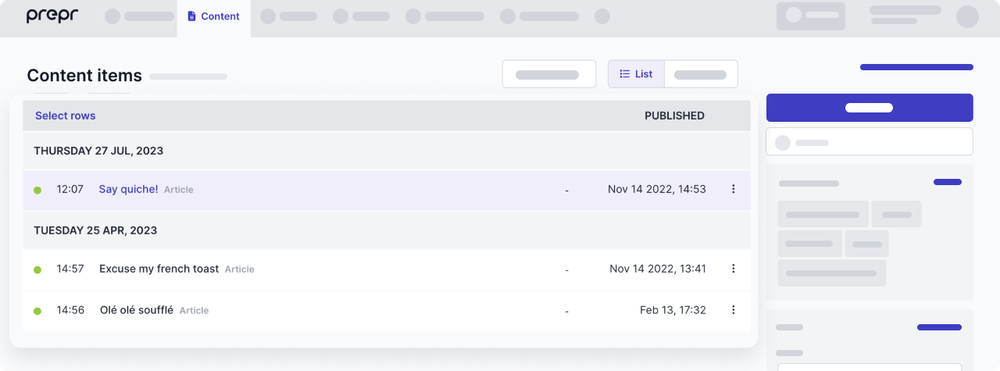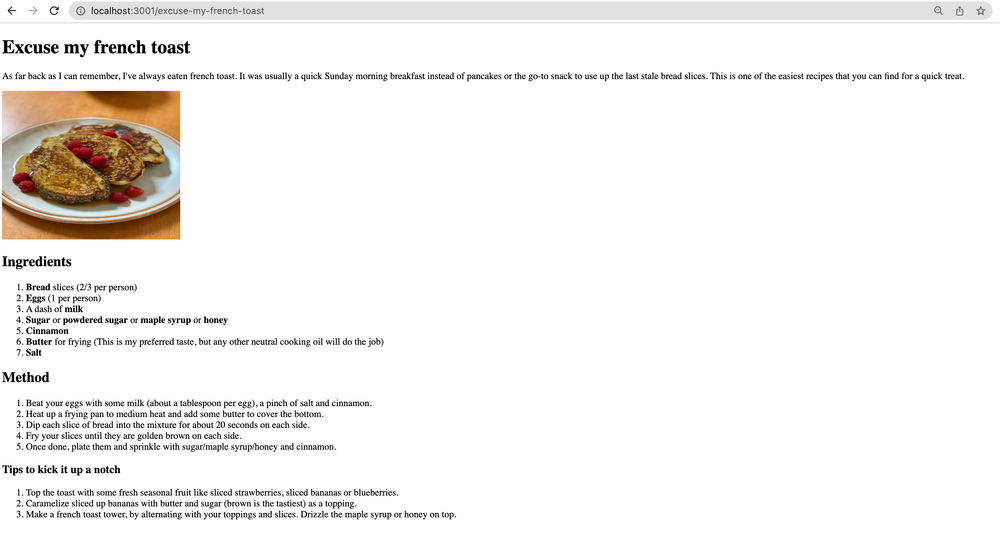Svelte Quick start guide
Estimated duration: 10 minutes
This guide shows you how to connect Prepr to a Svelte project to get data from Prepr CMS. You'll learn how to make a simple blog with Svelte and Prepr CMS. By the end of this guide, you'll have a working app that looks like the image below.

If you want to skip ahead, try out the zero installation demo on Stackblitz (opens in a new tab) or clone the repository on GitHub (opens in a new tab) to run the demo locally.
Prerequisites
You need to have the following setup before you connect your Svelte project to Prepr.
- A free Prepr account (opens in a new tab)
- An environment with demo data in Prepr
- The latest version of Node.js (opens in a new tab)
Step 1: Create a new Svelte project
The instructions below will guide you on how to create an empty Svelte project for your blog app.
If you have an existing Svelte project, then you can skip this step.
- Execute the command below to create a new Svelte project called
prepr-svelte. Choose askeleton projectand defaults for the remaining options.
npm create svelte@latest prepr-svelte- When the project is successfully created, go to the
prepr-sveltefolder, the root directory of the project, and execute the commands below to start the project.
cd prepr-sveltenpm installnpm run dev-
You should now be able to view your app on your localhost, for example,
http://localhost:5173/. -
Open your Svelte project with your preferred code editor.
-
Go to the
src/routesfolder and update the+page.sveltefile with the following code to display your blog:
<svelte:head>
<title>My blog site</title>
</svelte:head>
<section>
<h1>
My blog site
</h1>
</section>You should now see something like the image below on your localhost.

Step 2: Connect to Prepr
Set up a connection to Prepr to retrieve CMS data with GraphQL. The instructions below show you how to connect to Prepr directly from your project so that you can execute GraphQL queries to request data from the Prepr API.
- Create a folder called
libin thesrcfolder. Then, create a file calledprepr.jsin this folder. Copy the following code to this file to set up the endpoint:
import { PREPR_ENDPOINT } from '$env/static/private'
const prepr = async (query, variables) => {
const response = await fetch(PREPR_ENDPOINT, {
method: 'POST',
headers: {
'Content-Type': 'application/json'
},
body: JSON.stringify({ query, variables }),
})
return response
}
export default prepr- We recommend using environment variables to store sensitive information like access tokens. To add environment variables, create a
.envfile in the root directory of your project and add the API URL as follows:
PREPR_ENDPOINT=<YOUR-PREPR-API-URL>-
Replace the placeholder value
<YOUR-PREPR-API-URL>with the API URL of an access token from Prepr. Get this URL by logging into your Prepr account:a. Go to Settings → Access tokens to view all the access tokens.
b. Copy the API URL value from the GraphQL Production access token to only retrieve published content items.

Use the GraphQL Production API URL to request published content items for your live app and use the GraphQL Preview value to make a preview of unpublished content items for your content editors.
If your app runs without errors, then the setup above was done correctly. The next step is to fetch content from Prepr using the endpoint that you set up.
Step 3: Fetch multiple articles
Now that your app is connected to Prepr, fetch the blog articles from Prepr.
Add a GraphQL query
-
Create a
queriesdirectory in thelibfolder that you just created and create a file namedget-articles.js. -
Add the following query to this file to retrieve all articles:
const GetArticles = `
query {
Articles {
items {
_id
_slug
title
}
}
}
`
export default GetArticlesYou can create and test GraphQL queries using the Apollo explorer (opens in a new tab) from Prepr. Open the API Explorer from the Article content item page in Prepr or the access token page.
If you’re using preloaded demo data in your Prepr CMS environment, as mentioned above in the Prerequisites section, you should have a few published articles as shown in the below image. The query will retrieve the ID, Slug, and Title of each article.

In the next step, we'll fetch and process the query response.
Fetch data
Now that the query has been added, fetch the articles from Prepr and display them in the app.
- Go to the
src/routesfolder and create a file called+page.server.jsto execute the query that you just created as follows:
import prepr from '$lib/prepr'
import GetArticles from '$lib/queries/get-articles'
export async function load() {
const response = await prepr(GetArticles)
const { data } = await response.json()
const { items } = data.Articles
return {
articles: items
}
}- Next, update the
+page.sveltefile to display the retrieved data by adding the following HTML:
<script>
export let data;
</script>
<svelte:head>
<title>My blog site</title>
</svelte:head>
<section>
<h1>
My blog site
</h1>
<!-- list each retrieved article -->
<ul>
{#each data.articles as article}
<li>
{article.title}
</li>
{/each}
</ul>
</section>Now when you view the website on your localhost, you'll see something like the image below.

Step 4: Fetch individual articles
Now that you have the list of articles, add links to them. When a visitor clicks on a link, your app should open a detailed article page automatically. The instructions below show you how to create a route from the main page to the detailed page and how to fetch the article details based on the slug of the article that was clicked.
Add links
First add links to the articles.
- Update the
+page.sveltefile to include a link on each article title as shown in the code below.
<script>
export let data;
</script>
<svelte:head>
<title>My blog site</title>
</svelte:head>
<section>
<h1>
My blog site
</h1>
<ul>
{#each data.articles as article}
<li>
<!-- add link to reference an article slug -->
<a href="{article._slug}">{article.title}</a>
</li>
{/each}
</ul>
</section>Now when you view the app, each article has its own link. When you click on the link, a new page opens with the slug in the URL, but a Page 404 error is displayed. Continue with the next step to fetch the article details and resolve this error.
Fetch article details
Add another query to fetch a specific article by its slug and make this page visible when clicking on an article.
- Create a file called
get-article-by-slug.jsin thequeriesfolder and add the following query to this file to query a specific article by its slug:
const GetArticleBySlug = `
query ($slug: String) {
Article (slug: $slug) {
_id
title
content {
__typename
... on Text {
body
text
}
... on Assets {
items {
url
}
}
}
}
}`
export default GetArticleBySlugNow that the query is added, fetch the individual article by its slug. Fetch the article title and the article content.
The Article content is stored in a Dynamic content field. Check out the GraphQL docs for more details on how to fetch the data within this field.
- Go to
src/routes/and create a folder called[slug]and a new+page.server.jsfile with the following code to execute the query that you just created:
import prepr from '$lib/prepr'
import GetArticleBySlug from '$lib/queries/get-article-by-slug'
export async function load({ params }) {
const response = await prepr(GetArticleBySlug, {slug: params.slug})
const { data } = await response.json()
return {
article: data.Article
}
}- Create a new
+page.svelteto display the article detail page as follows:
<script>
export let data;
</script>
<svelte:head>
<title>{data.article.title}</title>
</svelte:head>
<div>
<h1>
{data.article.title}
</h1>
{#each data.article.content as content}
<div>
{#if content.__typename === 'Assets'}
<img src="{content.items[0].url}" width="300" height="250"/>
{:else if content.__typename === 'Text'}
{@html content.body}
{/if}
</div>
{/each}
</div>Now, when you view your site, you can click on an article which will direct you to that specific article like in the image below.

All done
Congratulations! You have successfully connected a Svelte project to Prepr for a simple Blog app.
Next steps
To learn more on how to expand your project, check out the following resources:
Was this article helpful?
We’d love to learn from your feedback